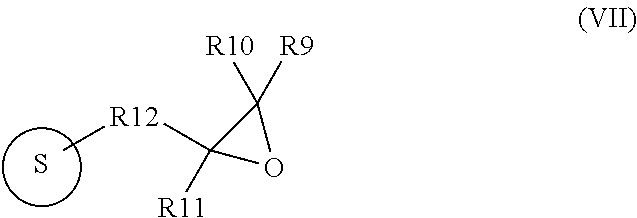Process for removing degradation acids from hydroformylation reactions
a technology of hydroformylation reaction and degradation acid, which is applied in the direction of physical/chemical process catalyst, organic compound/hydride/coordination complex catalyst, separation process, etc., can solve the problems of significant loss of phosphorus ligands, and many such phosphorus ligands can be degraded
- Summary
- Abstract
- Description
- Claims
- Application Information
AI Technical Summary
Benefits of technology
Problems solved by technology
Method used
Image
Examples
example 1
Model Experiment
[0051]This example illustrates that a silica gel supported epoxy compound can remove a degradation acid from a homogeneous solution.
[0052]A commercially available diphenylphosphinic acid was used in this example because it has a pKa similar to phosphorus acid and bears some structural similarity to the degradation acid α-hydroxyalkylphosphonic acid as disclosed by Bryant (Catalyst Separation, Recovery and Recycling-Chemistry and Process Design, Edited by David J. Cole-Hamilton and Robert P. Tooze, Springer, 2006, Chapter 2, Page 25 to Page 27). Thus, 2.2 grams of diphenylphosphinic acid was dissolved in 100 ml of di-2-ethylhexyl phthalate (DOP) under nitrogen at 90° C. and stirred for 20 min. The acidity of this solution was about 0.1M (or 100 miliequivalent per liter).
[0053]Then, 30 grams of glycidoxypropyl-functionalized silica gel (SiliaBond® Glycidoxy or Si-Gly, epoxide equivalent is about 1 mmol / gram, bulk density is 0.47 to 0.53 kg / L, particle size 40 to 60 μm,...
example 2
Comparative Experiment
[0059]This example illustrates that an unfunctionalized, regular silica gel does not provide the removal benefits of the epoxy-modified material.
[0060]Under the same reaction conditions as described in Example 1, 30 g of regular unfunctionalized silica gel (available from Aldrich, 70 to 230 mesh, BET surface area is about 500 m2 / g) was used to replace SiliaBond® Glycidoxy.
[0061]After 3.5 hrs at 90° C., titration showed less than 5% acid was no longer present in the solution.
[0062]After 6 hours, the silica gel was recovered, washed, and extracted with acetone in the same way as described in Example 1.
[0063]A SEM analysis showed no evidence of phosphorus present on the surface of this recovered silica gel.
example 3
Model Experiment
[0064]This example illustrates that a polymer bounded epoxide resin can remove a degradation acid from a homogenous solution.
[0065]The same commercially available diphenylphosphinic acid was used in this example as in Example 1. 90 grams of poly(ethylene-co-glycidyl methacrylate) resin beads (available from Aldrich, containing about 8% of glycidyl methacrylate by weight, epoxide equivalent is about 0.05 mmol / gram) were soaked in 100 ml of di-2-ethylhexyl phthalate (DOP) in a flask and stirred for 48 hours at ambient temperature and then for another 48 hours at 90° C. with agitation.
[0066]2.2 grams of diphenylphosphinic acid was then added to the flask under nitrogen. The reaction temperature of the solution was maintained at 90° C. and agitated. The initial acidity of this solution was about 0.1M (or 100 milliequivalent per liter).
[0067]After 3 hours, an aliquot of 10 ml of the solution free of polymer beads was taken, diluted with 95 ml of isopropyl alcohol and 5 ml...
PUM
| Property | Measurement | Unit |
|---|---|---|
| pressure | aaaaa | aaaaa |
| temperature | aaaaa | aaaaa |
| particle size | aaaaa | aaaaa |
Abstract
Description
Claims
Application Information
 Login to View More
Login to View More - R&D
- Intellectual Property
- Life Sciences
- Materials
- Tech Scout
- Unparalleled Data Quality
- Higher Quality Content
- 60% Fewer Hallucinations
Browse by: Latest US Patents, China's latest patents, Technical Efficacy Thesaurus, Application Domain, Technology Topic, Popular Technical Reports.
© 2025 PatSnap. All rights reserved.Legal|Privacy policy|Modern Slavery Act Transparency Statement|Sitemap|About US| Contact US: help@patsnap.com



